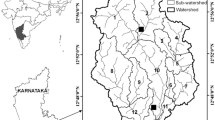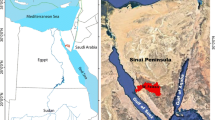Abstract
Sustainability of watershed development plan is assessed through the quantification of thethree major sub-components of Water Balance, namelySurface Runoff (SR), Ground Water Recharge (GWR) andEvapotranspiration (ET) for 71 micro-watersheds of Kharod watershed (1100 km2 area) located in Western India. Annual estimates at micro-watershed level are carried out for two scenarios: A) The current water resources and land use/land cover scenario and B) Envisaged changed water resources and land use/land cover scenario after implementing all prescriptions for micro-watershed development. Finally water balance components level analysis and comparison was done to see the impact and assess the sustainability of envisaged watershed development scenario. It is estimated that there is a decrease of 40.2 mm in surface runoff component, increase of approx. 4 mm in groundwater recharge, increase of 102.3 mm in actual evapotranspiration for post-developmental scenario on annual basis. The computation of actual evapotranspiration (ETa) showed that there is net increase in the ETa after the post-development scenario. Also the surface water storage has increased from 21.2 mm to 65.3 mm. Overall there is 164.9 mm of available water balance after implementation of developmental activities which reflects the sustainability of the proposed development plans.
Similar content being viewed by others
References
Anonymus (1994). Central Ground Water Board. Manual on artificial recharge of groundwater, Technical Series, M. No. 3.
Anonymus (1997). Ground Water Recharge Estimation Committee Report (GWREC). Central Ground Water Board, New Delhi, pp. 25–36.
Anonymus (2001). Water Balance study of Krishnai River Basin according to Thornthwaite’s concept of Potential Evapotranspiration. National Institute of Hydrology, Report: CS/AR-2/2000–01.
Burman, R. and Pochop, L.O. (1994).Evaporation, Evapotranspiration and Climatic Data Part of series-Developments in Atmospheric Science, pp. 22, 30–39, 126–140 and 198–199.
Hargreaves, GH. and Samani, Z.A. (1982). Estimating potential evapotranspiration. Tech. Note,Journal of Irrigation and Drainage Eng., ASCE,108(3): 225–230.
Hargreaves, G.H. and Samani, Z.A. (1985). Reference crop Evapotranspiration from temperature.Applied Engg. in Agric,1(2): 96–99.
Kunchwar, D.S. (2003).Surface runoff and sediment yield modeling using remote sensing and GI techniques. A Dissertation Report in Master of Engineering (Civil) in Hydraulic Structures submitted to the Maharaja Sayajirao University of Baroda.
Muralidharan, D. and Athavale, R.N. (1998). Artificial-recharge in India. Compiled under the Rajiv Gandhi National Drinking Water Mission, Technical Report, NGRI, Hyderabad.
Navalgund, R.R., Singh, T.P., Sharma, T., Satya Kiran, P.V. and Trivedi, A.V. (2001). Hydrologie response of a watershed to land use changes: A remote sensing and GIS approach.Int. Journal Remote Sensing,22(11): 2095–2108.
Raju, K.C.B. (1963).Groundwater possibilities in Kutch district, Gujarat. Geological Survey of India, Miscellaneous publication No. 14. Groundwater (Part-I). pp. 201–208.
Raju, K.C.B. (1998). Importance of recharging depleted aquifers: State-of-the-art artificial-recharge in IndiaJournal of Geological Society of India,51: 429–454.
Richard, J.C. (1971). Introduction to Physical Hydrology. Methuen and Co. Ltd., London, pp. 211.
Rick, A., Dirk, R., Garcia, M. and Herbas, C. (2004). Dynamics of reference Evapotranspiration in the Bolivian highlands (Altiplano).Agricultural & Forest Meteorology,125(1-2): 68–82.
Sharma, A.K., Ghosh, R., Patel, J.G., Tamilarasan, V. and Nayak, S.R. (2005). Land and water resources development plans for Kachchh District, Gujarat, Technical Report, SAC/RESIPA/MWRG/ESHDAW 24/2005. pp 62.
Author information
Authors and Affiliations
Corresponding authors
About this article
Cite this article
Sharma, A.K., Thakur, P.K. Quantitative assessment of sustainability of proposed watershed development plans for kharod watershed, western India. J Indian Soc Remote Sens 35, 231–241 (2007). https://doi.org/10.1007/BF03013491
Received:
Revised:
Issue Date:
DOI: https://doi.org/10.1007/BF03013491




